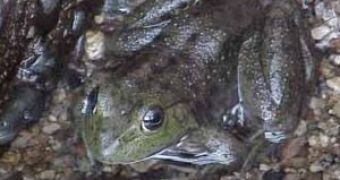Five known extinction waves have been experienced by the Earth, but the current one is the first one that has likely been triggered by human activity.
The World Conservation Union says that the rapid loss of bird, mammal and amphibian species in recent decades is estimated at being between 100 and 1,000 times higher than the "background" or expected natural extinction rate.
In the last 500 years, human activity has forced 844 species to extinction. Amphibians are indicator species of the environmental health. Their highly permeable skin is extremely sensitive to changes in the environment (freshwater and air quality). "Amphibians are one of nature's best indicators of overall environmental health," said Russell A. Mittermeier, president of Conservation International.
In 2004, the first global assessment showed that 32% of the world's 5918 amphibians are now threatened with extinction. At least nine species have gone extinct since 1980, when the most dramatic declines began. Another 113 species have not been reported from the wild in recent years and are considered to be possibly extinct.
A range of factors causes the disappearance of amphibians, including infections, habitat loss and changing temperature or rain patterns.
Live North American bullfrogs (Rana catesbeiana) (photo above), traded for their legs, seem to have spread in Europe the lethal infection with the fungus Batrachochytrium dendrobatidis in the region. Unwittingly, this will wipe out the European frog species populations.
The fungus lives in the moist skin of the amphibians, obstructing its breathing function which finally leads to the individual's death. This infection has already vanished many amphibian species in Australia, Central and South America. Now it's sweeping the Mediterranean basin. Around 25 % of amphibians that live around the Mediterranean basin are threatened by extinction, according the World Conservation Union's latest regional Red List. Over half of the basin's 106 amphibians are unique.
One, the Israel painted frog (Discoglossus nigriventer), is now officially extinct and this is due to human change on its habitat since 1950's.
As elsewhere, wetlands drainage and pollution of what remains of them were already the main culprits behind the animals' demise.
And now European amphibians are also threatened by the fungal disease that is sweeping whole amphibian populations throughout the world.
The fungus could now hasten the end of Europe's midwife toads (Alytes species) (photo bellow), famed for carrying their eggs until they hatch, and the fire salamander (Salamandra salamandra). "Disease is the bullet killing frogs, but climate change is pulling the trigger," says Alan Pounds, an ecologist at the Monteverde Cloud Forest Preserve and Tropical Science Center in Costa Rica.
His team discovered that changes in humidity and temperature induced by global warming favored the fungal dissemination and infection. "We have to reduce concentrations of greenhouse gases very soon if we are to avoid massive losses of biodiversity."

 14 DAY TRIAL //
14 DAY TRIAL // 
